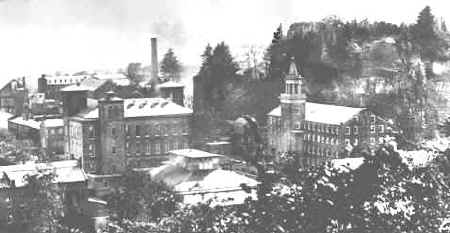Colt has been in the news lately. Here is the story on how it all started:
The first manufacturing plant was located in Paterson, NJ - the city where I was born.

The
Colt Gun Mill
One
of Paterson's most
famous industries
was the Patent
Arms Manufacturing
Company, begun by
Samuel Colt.
In 1836, the Colt
Gun Mill, a
magnificent
four-story
brownstone
building, was
built on an area
directly below the
waterfalls. Here,
Colt first
manufactured his
newly patented
repeating firearm,
the revolver, with
mother of pearl
handles, which
were essential in
securing the
American frontier.
Between 1836 and
1841,
approximately
5,000 muskets
rifles, and
revolvers were
made here.
Link to Colt Manufacturing History Webpage. 
Excerpt from the Maxman Report:
The
Gun Mill was
constructed by the
Patent Arms
Manufacturing
Company in 1836,
on the original
site of a rolling
mill and nail
factory. The Gun
Mill was a
four-story
brownstone
structure, with a
central projecting
stair tower. A
weathervane in the
shape of a gun
capped the
belltower, and
encircling the
factory was a
picket fence, in
which each picket
was shaped as a
wooden gun.

The
Colt Gun Mill, on
the right.
The
revolvers patented
by Samuel Colt
were manufactured
in this building
until 1842, when
the company
failed. Beginning
in the 1840's,
the site was given
over wholly to the
manufacture of
silk and other
textiles; the
first manufacture
of sewing silk in
the United States
reputedly took
place on this
site. As the
demand for silk
grew, the partners
John Ryle and G.
W. Murray refitted
the fifth floor of
the Gun Mill as a
weaving shop and
constructed three
new buildings on
the Gun Mill
property closer to
the river. These
buildings – a
two-story stone
structure, a dye
house, and another
structure –
subsequently
became part of the
Knipsher &
Maass complex. A
new boiler was
added on the north
side of the Gun
Mill at the turn
of the century.
In
the 1920's, the
upper two floors
of the Gun Mill
were razed because
they were
considered unsafe
for machinery.
This demolition
followed the
razing of the
fifth floor of the
mill and the top
floor and
colonnaded lookout
of the bell tower,
which took place
sometime prior to
1890. The
blacksmith shops
located to the
west of the old
mill were
demolished by
1931, and between
1931 and 1937
additional
building elements
were constructed
along the south
and west facades
of the old mill.
In
1983 the mill was
closed down and
the property
purchased by the
Paterson
Renaissance
Partners. A series
of arson fires
reduced this
building and its
surrounding
ancillary
structures to
ruins. Portions of
all of the
original walls of
the 1836 Gun Mill
are intact,
including the
first two stories
of the projecting
stair tower. One
wall of the copper
works, constructed
prior to 1899 and
located to the
southeast of the
main building,
remains standing.
The heavy wall
directly south of
the Gun Mill
fronting onto the
raceway may date
to the 1820s –
30s. Immediately
behind the Gun
Mill are a few
walls which were
first visible on
the 1931 Sanborn
map.

The
Colt Gun Mill
Today
More on the history of the Colt Gun Mill. (Historic American Engineering Record, No. NJ-17)
At this time, a partial restoration of the Colt Mill is planned. This work will be funded by the New Jersey Historic Trust.
View diagram of proposed use of Colt Mill contained in the
Maxman Report.
(Drawing, courtesy
of Ed Rutsch)
Source: http://patersongreatfalls.org/coltgunmill.html
Please click on the above links for more information!
 |
| This street in Downtown Paterson was named after him |
Samuel Colt (July 19, 1814 – January 10, 1862)

I guess if it wasn't steam powered, water power is next best. Certainly less expensive.
ReplyDeleteGreat post.
Paterson used to be called "The Silk City" because of all the textile mills that surrounded the Great Falls. Haven't been down there in years and years. It's a shame really - lots of the city's early colonial history is just being destroyed and forgotten.
Delete